Tomb of Cyrus the Great: Achaemenid Empire Founder
Iran's Achaemenid Empire Originator

The Tomb of Cyrus stands as a significant historical monument from the Achaemenid era, attracting those fascinated by ancient Iranian history. Constructed from limestone blocks, the structure of the tomb features platforms upon which the main burial chamber rests. Its architectural style represents a blend of influences from Persia, Anatolia, Egypt, Ilam, and Mesopotamia.
Remarkably, the edifice was built without any mortar, highlighting the uniqueness of its architectural design. Due to its distinctive architecture, the Tomb of Cyrus has withstood natural elements like snow and rain for centuries.
Cyrus the Great, the founder of the Achaemenid Empire in Iran and its most celebrated ruler, based his reign on principles of justice and love for his people, gaining fame across the ancient East and West. Ruling for about 30 years, he presented a great civilization to the world.
The Cyrus Cylinder, one of his most important surviving artifacts, illustrates his humanitarian policies. Cyrus met his end in battle against the Massagetae, a nomadic Scythian tribe, and was buried in Pasargadae.
Read More: Pasargadae Travel Guide
The significance of Cyrus’s tomb is enhanced by its connection to one of the most important political figures globally. Located within the ancient site of Pasargadae near Shiraz in the Marvdasht city, this simple yet unique structure is situated a kilometer away from other Pasargadae palaces. Its construction mirrors that of the Chogha Zanbil ziggurat, suggesting that no similar structure existed in Iran or abroad before it, though similar monuments were later erected. The Daughter’s Tomb in Dashtestan, Bushehr province, is another Achaemenid-era historical monument bearing a strong resemblance to Cyrus’s tomb. Ferdowsi’s Tomb in Tus is among the most notable modern structures inspired by the original design of Cyrus’s Tomb.
Surrounding the Tomb of Cyrus, numerous structures once existed but have since disappeared. Positioned in the vast Murghab plain, the tomb is visible from all directions. Greek sources also describe Cyrus’s Tomb, with some claiming to have seen its interior. References to the architectural design of the tomb in the book “Anabasis” suggest that its structure has remained unchanged for years, preserving its historical essence to the present day.
SURFIRAN Tours
Best Iran Tours
Contents
Access Route to the Tomb of Cyrus
To visit the Tomb of Cyrus, your journey begins with a trip to Shiraz. After exploring the attractions of Shiraz, head onto the Shiraz–Isfahan highway. Passing through Saadat Shahr and reaching a side road, you’ll cover 20 kilometers to arrive at the village of Madar-e Soleyman. From this village, a four-kilometer drive will lead you to Pasargadae. The total distance from the beginning of the Shiraz-Isfahan road to Pasargadae is approximately 132 kilometers.

Visiting Information for the Tomb of Cyrus
Many tourists prefer the spring season for visiting Shiraz. The visiting hours for Pasargadae vary across different seasons of the year.
Visiting Hours for Pasargadae in Spring and Summer
- From 8:30 AM to 7:30 PM, with ticket sales from 8 AM to 7 PM.
Visiting Hours for Pasargadae in Autumn and Winter
- From 8:30 AM to 5:30 PM, with ticket sales from 8 AM to 5 PM.
Planning your visit according to these timings ensures a seamless experience as you explore this historic site.
History of the Tomb of Cyrus
Archaeologists attribute the antiquity of the Pasargadae area to pre-Achaemenid periods. The construction of the Tomb of Cyrus and the surrounding structures dates back to Cyrus’s reign. The tomb was built between 530 and 540 BC, with other Pasargadae complex structures completed during subsequent Achaemenid rulers’ reigns. During the Achaemenid period, the Tomb of Cyrus was considered a sacred edifice.
Historical sources indicate that the tomb’s construction was ordered by Cyrus himself before his death. According to records from the Achaemenid era, the Murghab plain, which encompasses the Tomb of Cyrus, was once a vast and verdant garden containing a collection of grand palaces.
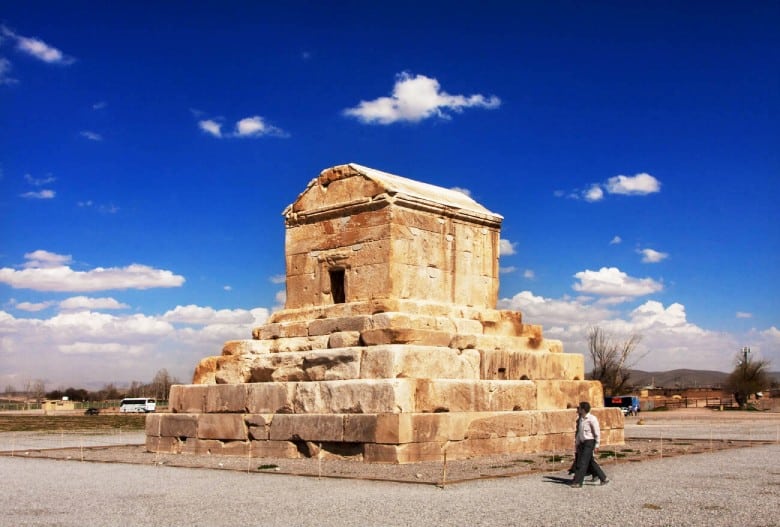
Who Discovered the Tomb of Cyrus?
During the Islamic era, the exact original purpose of the structure was unclear to people, who attributed the construction of such magnificent stone buildings beyond human capability to Solomon. Thus, the Tomb of Cyrus the Great was considered one of Solomon’s buildings, and it was associated with his mother, referred to as the “Tomb of Solomon’s Mother.”
Jan Janszoon Struys, a Dutch traveler who visited Pasargadae in the 17th century, mentioned the Tomb of Solomon’s Mother as a pilgrimage site, specifically for women. In his travelogue, he wrote: “Faithful women… would rub their foreheads against the tomb three times and kiss it the same number of times, utter a short prayer under their breath, and leave.”
James Morier, a British diplomat and writer, was the first to theorize that the tomb might belong to Cyrus the Great. In 1809, he proposed that the structure, known as a pilgrimage site during the Islamic period, could be the tomb of Cyrus the Great; however, he later dismissed this possibility, suggesting that Cyrus’s tomb was located near Fasa.
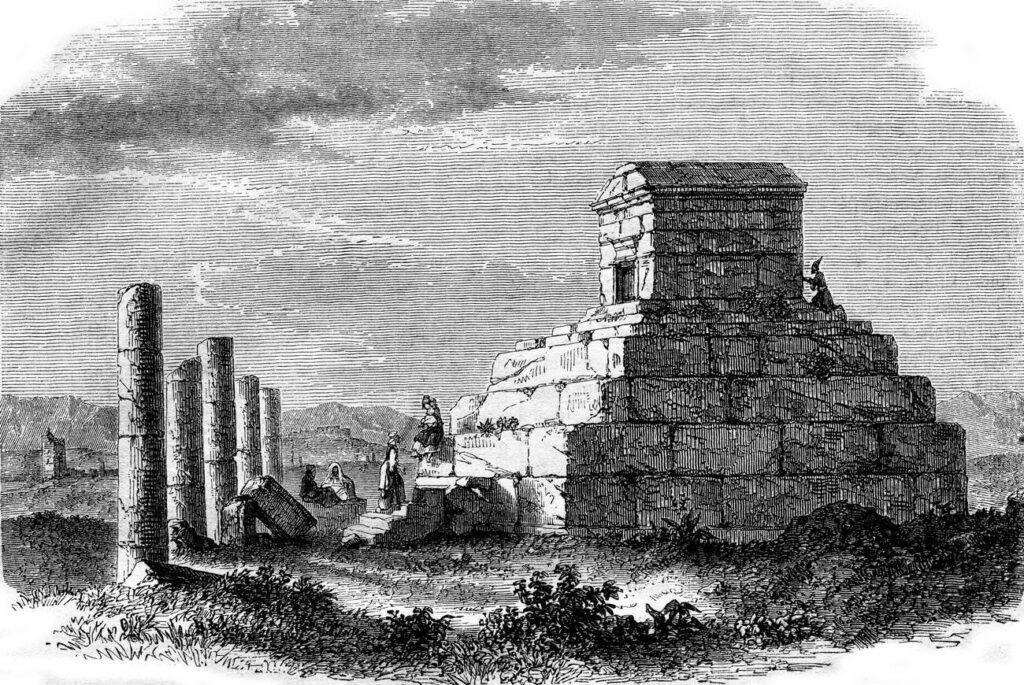
Following him, the German researcher Georg Friedrich Grotefend, by examining Morier’s travelogue and identifying Cyrus’s name in the Murghab inscription, speculated that the Murghab plain was indeed Pasargadae. Experts say that more than 2550 years ago, the Murghab plain was a vast, dreamlike garden protected by numerous guards and servants of Cyrus’s Tomb.
In 1818, Sir Robert Ker Porter, an English writer, painter, traveler, and diplomat, visited Pasargadae and recognized the structure as the very Tomb of Cyrus the Great mentioned by ancient European writers. He is credited as the first to assert, by correlating the writings of Bisotun and Pasargadae, that the tomb known among the locals as the Tomb of Solomon’s Mother was in fact the resting place of Cyrus the Great, the Achaemenid king.
Born into a family of culture and art, with famous novelists Anna Maria Porter and Jane Porter as his sisters, Robert was appointed as a court painter by Tsar Alexander I after his visit to Russia in 1804 and married a Russian princess. The Russian Academy of Fine Arts then commissioned him to paint Persepolis and other Iranian sites, earning him significant fame from his extensive travels and paintings of Pasargadae.
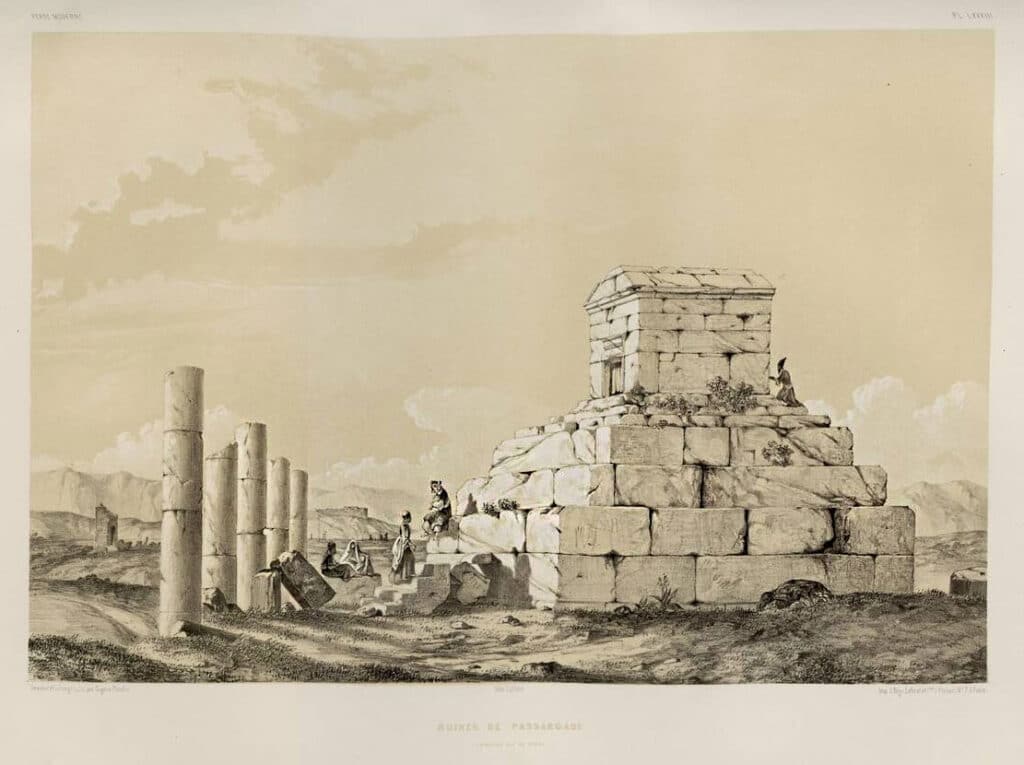
Entering Iran through the Caucasus in 1817, Porter traveled through Tehran and Isfahan to Persepolis and Pasargadae, painting his historic depiction of the Tomb of Cyrus the Great, which had remained unidentified until then. His portrait of Fath-Ali Shah Qajar is another significant work in Iran, for which he was awarded the Order of the Lion and the Sun.
Illness and subsequent death prevented Porter from completing his research, but many historical sources regard him as the principal discoverer of Cyrus the Great’s Tomb. A travelogue titled “Robert Ker Porter” remains, containing his paintings of ancient artifacts.
Claudius James Rich, a French travel writer and Iranologist, validated the theories of James Morier and Robert Porter before his death in 1821. After meeting Sir Robert Porter and learning about his drawings and archaeological findings, Rich traveled to Iran in 1820, documenting his daily observations in his diary. He passed away in Shiraz a year later, still, some disputed Porter’s view on the Tomb of Cyrus; however, Rich endorsed his statements in his book, writing: “In my opinion, this building must be the tomb of the greatest, most illustrious, and most appealing ruler of the East, namely Cyrus.”
Architecture of the Tomb of Cyrus
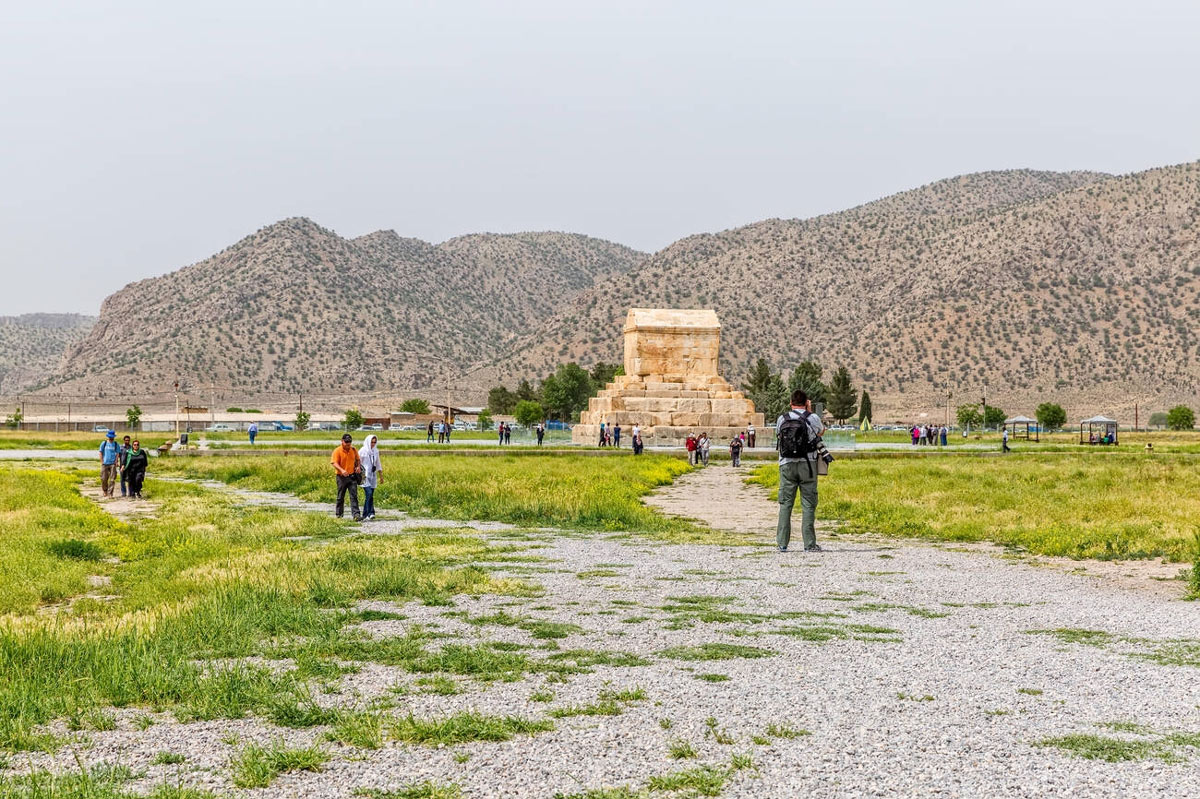
Roman Ghirshman considers the city of Pasargadae a prime example of Iranian architectural art. The city connects with the art of the Medes on one hand, while its winged bulls draw inspiration from the Assyrian Empire on the other.
The architectural style of the building has sparked various opinions, with many experts attributing its origins to a blend of influences from Greek Anatolia, Mesopotamia, Egypt, Elamite, and authentic Iranian sources. Bahram Farahvoshi has written about the cypress-shaped covering on the Tomb of Cyrus, suggesting that the graves of Aryans who first arrived in Sialk were covered in the same manner, indicating that the earliest Achaemenid kings constructed their tombs according to an ancient tradition prevalent in the rain-rich regions of northern Iran.
The Tomb of Cyrus is the most intact structure in Pasargadae, offering a design that is dignified, captivating, balanced, and proportionate. This tomb, with its utterly simple appearance, resembles a house standing 11 meters tall, with its roof from the outside forming a gabled shape. The base or the main foundation of the building is a platform made of square stones, showcasing a rectangular shape with dimensions of 13.35 meters in length and 12.30 meters in width.
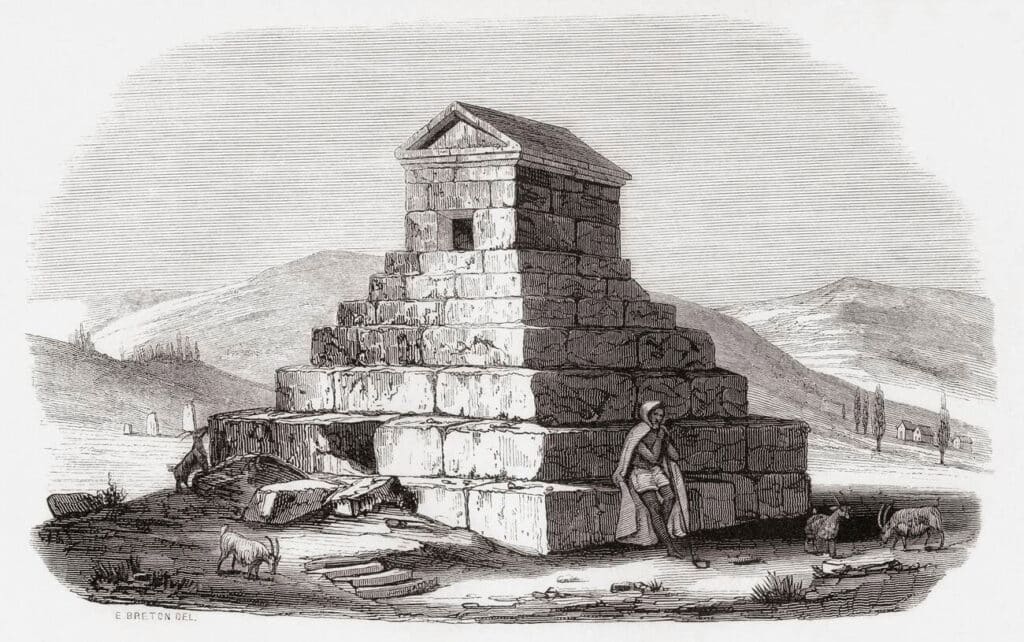
The structure consists of two distinctly separate parts: a six-step stone platform and a room with a gabled roof atop the sixth step. The first step, forming the base platform, is 165 centimeters high, but about 60 centimeters of it was originally uncarved and hidden; in essence, this step, like the second and third, was precisely 105 centimeters high. The fourth, fifth, and sixth steps each have a height of 57.5 centimeters. The platforms are half a meter wide, and the surface of the sixth platform, serving as the base of the tomb chamber, measures about 6.40 meters by 5.35 meters.
Above the Tomb of Cyrus, there was a stone chamber topped with a flat roof, over which a gabled structure was built. The chamber had a low doorway. Arianus, a historian from the era of Alexander the Great, claims to have seen the inside of the tomb and describes it thus: Inside the chamber was a golden sarcophagus where Cyrus’s body had been placed. Beside the sarcophagus stood a bench with golden legs, covered with a Babylonian tapestry and the floor with carpets. Trousers and garments of the Medes in the room each had different colors. Gold ornaments from necklaces and earrings to swords were present in the chamber. Outside the tomb, spiritual leaders were guarding Cyrus’s tomb.
According to Arianus, after looting and destroying Persepolis, the Macedonian king visited Cyrus’s tomb. He ordered Aristobulus, one of his warriors, to enter the tomb. Inside, they found a golden throne, a table of drinking vessels, a golden sarcophagus, and several jewel-encrusted ornaments, along with an inscription on Cyrus’s tomb that read:
“O man, I am Cyrus, son of Cambyses, who founded the empire of the Persians, and was king of Asia. Do not therefore grudge me this monument.”
Cyrus the Great
No archaeological evidence has verified the existence of such an inscription; even among historians who mentioned this writing, there is considerable debate about its precise text. Apparently, the tomb was looted shortly after Alexander’s visit. When Alexander returned to the site, he was distressed by the tomb’s condition and ordered its restoration. Thus, if the mentioned inscription was damaged, he would have surely had it restored.
The tomb chamber measures 3.17 meters in length, 2.11 meters in width, and 2.11 meters in height. It has a massive wall 1.5 meters thick, constructed from four rows of carved stones. The first and second rows are taller than the third and fourth, and on the northwest side, there apparently was a double sliding door, now gone.
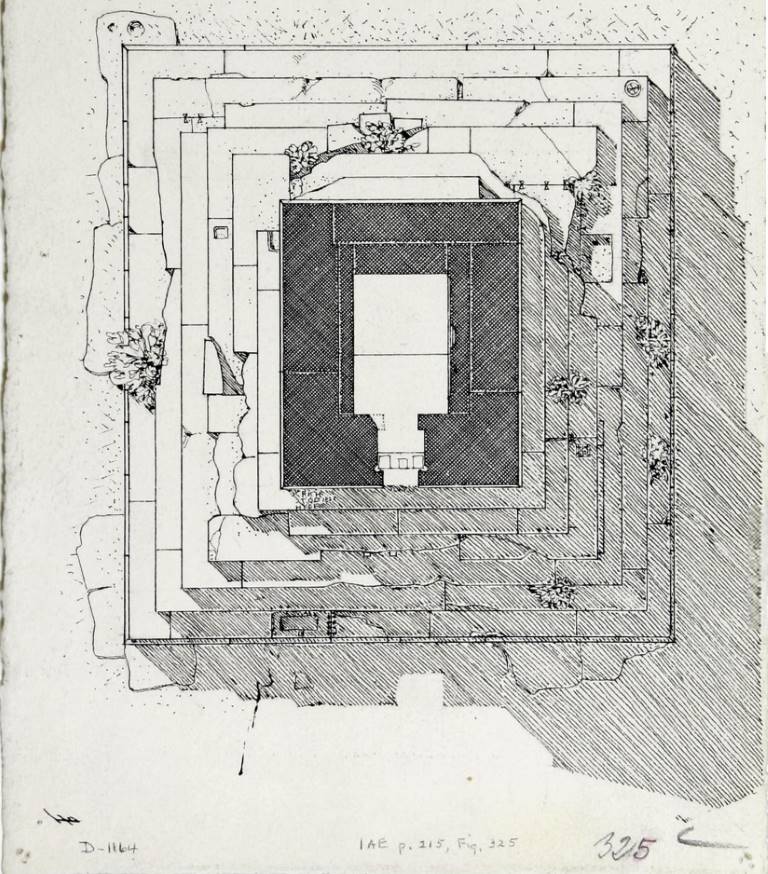

The interior roof of the tomb is flat, but the exterior has a gabled shape. The building’s dual-sloped design is set in an “eight” shape, and its roof is made of two heavy stones, each measuring 6 by 3 meters with a thickness of half a meter. An upper stone that once rested on the roof no longer exists. Some sources believe the empty space between the roof and the gable was where Cyrus’s body was kept. It’s also thought that, following Achaemenid tradition, the interior of the roof was hollowed out to lighten and facilitate the movement of the heavy stones.
Ernst Herzfeld was the first to notice that the tomb chamber of Cyrus had two doors, with the sockets for the door hinges still visible. Likely, two large stone doors overlapped each other, such doors, hard to open and close, were typically used for structures not meant for frequent access. These doors were about 130 centimeters tall, requiring one to bend to enter the chamber.
No decorations or engravings exist around or inside Cyrus’s Tomb, except for a very faint relief of a twelve-petal flower, a common Achaemenid motif, below the gable and above the entrance door. Additionally, no inscriptions or writings have been found in Cyrus’s Tomb.
Historical and archaeological research shows that ancient civilizations possessed sufficient knowledge to construct earthquake-resistant structures. In ancient Greece and Iran, a new technique emerged where various materials like pottery and clay were placed between the floor and the foundation of a structure to allow one layer to slide over another during an earthquake, minimizing damage. This technique, known as “base isolation,” is today one of the most effective tools for protecting buildings against earthquakes. Modern structural engineers use rubber bearings, ball bearings, and spring systems for base isolation and to reinforce buildings during earthquakes. An early example of the base isolation technique can be observed in the Tomb of Cyrus.
The foundation of the Tomb of Cyrus the Great consists of several layers of limestone; the first layer or base comprises stones bonded and smoothed with a lime plaster and ash or gravel mixture; higher layers consist of stone pieces connected with metal rods but not attached to the base layer. With this technique, during an earthquake, the upper layers slide over the base layer. It’s evident that the Tomb of Cyrus the Great has withstood numerous earthquakes over 2,500 years, though there’s insufficient data on their intensity or whether they were strong enough to affect the base isolation configuration.
Inscription of the Tomb of Cyrus
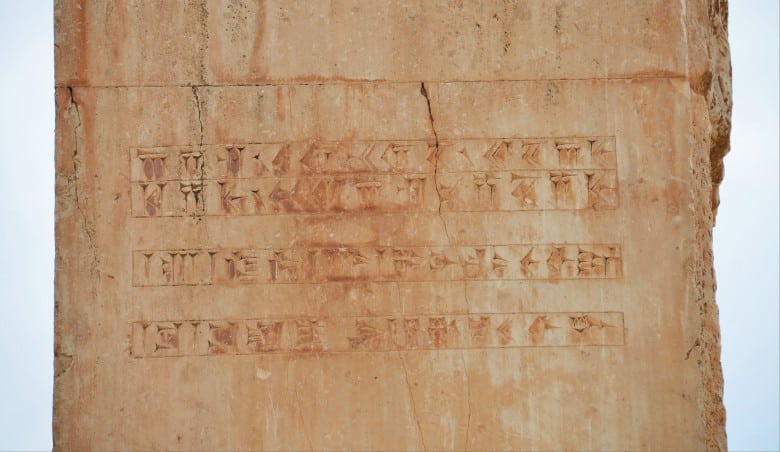
According to historical sources, an inscription existed in the Tomb of Cyrus, written in cuneiform script. Arian, a Greek historian, attributed the following inscription to the tomb of Cyrus in his writings:
“O man! I am Cyrus, the son of Cambyses, I founded the empire of the Persians. I ruled over Asia, now do not envy me.”
The authenticity of this inscription, allegedly found in Cyrus’s Tomb, remains uncertain; this manner of expression has not been observed in any Achaemenid-era inscriptions and bears a striking resemblance to Greek inscriptions. Greek historians Arian and Strabo claim to have seen the inside of Cyrus’s Tomb and described it.
Both mentioned a golden sarcophagus within the tomb. Currently, the only complete inscription in Pasargadae is engraved on the walls of palaces. These inscriptions are two lines long and written in Ancient Persian, Elamite, and Akkadian using cuneiform script.
Who Ordered the Construction of the Tomb of Cyrus?
Historical sources state that the Tomb of Cyrus the Great was constructed by his own command before his death. At that time, the tomb was built amidst a large, beautiful, and lush garden and was considered among the sacred and significant structures during the reign of the Achaemenid kings. According to historical sources, those appointed to protect the tomb were from the Zoroastrian clergy, and provisions such as daily food, wine, a sheep, and a horse for sacrifice in Cyrus’s honor were made available to them every month.
Secrets of the Tomb of Cyrus the Great
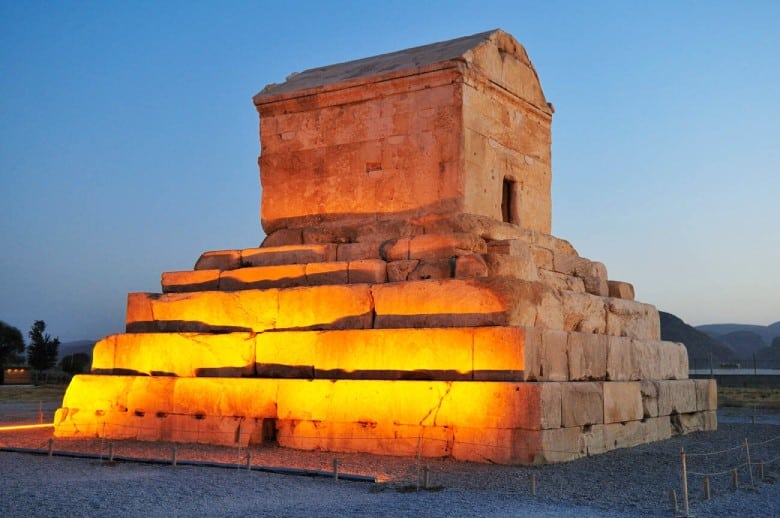
The complex of Pasargadae and the tomb of Cyrus the Great, shrouded in mystery for centuries, inspired numerous legends that blurred the line between fact and fiction. However, thanks to dedicated scientific efforts, key secrets of this tomb have been unveiled. Below, you will discover some of the most significant findings.
The Construction Material of Cyrus’s Tomb
The Tomb of Cyrus the Great was constructed from white marble stones. These stones were transported from Mount Sivand and were shaped into flat slabs. The construction involved six platforms forming the base, with a chamber built atop these platforms.
The Mystery of the Stone Assembly
What astonishes visitors is how these large, precisely cut stones were assembled with such accuracy and finesse without the use of mortar. Despite the absence of mortar, how have these large stones withstood the elements over the years without significant damage to the tomb? Interestingly, during construction, the large stones were connected using metal clamps, but no traces of these clamps remain today. If you look closely during a visit to the tomb, you can still see the holes where the stones were connected.
Archaeological Discoveries Inside the Tomb
Archaeologists discovered a hole inside the structure after cutting down a fig tree that had grown on the tomb, which led into the gable of the building. Further excavations revealed an empty space beneath the gable, initially thought to be Cyrus’s burial site. However, this theory has been disputed, and the exact location of Cyrus’s burial within the structure remains uncertain.
Placement of Cyrus’s Body within the Tomb
There have been various theories about how Cyrus the Great’s body was placed inside his tomb in Pasargadae. Arianus mentioned a golden sarcophagus inside the chamber, where Cyrus’s body was laid to rest. Some archaeologists, like Ali Sami, believed that Cyrus’s body was located in the space between the internal ceiling and the gable.
Historical Images of the Tomb
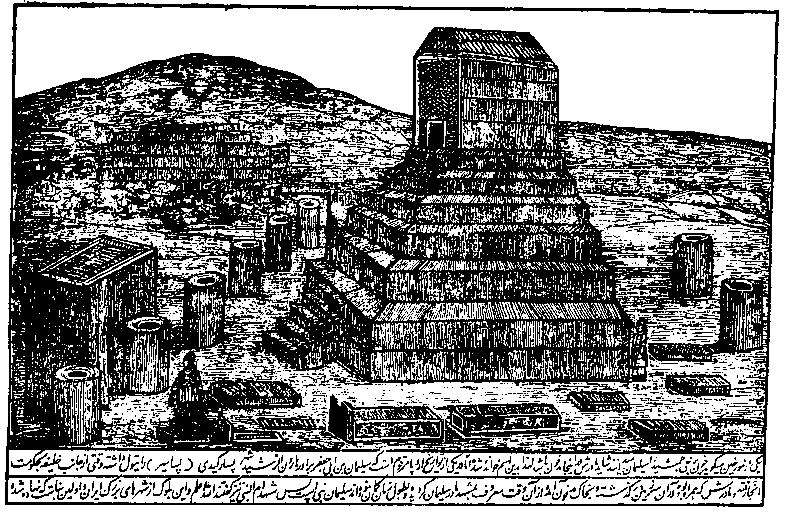
Photos of the Tomb of Cyrus from different times, derived from paintings by travelers and writings by travelogue authors, suggest that the area surrounding the tomb’s structure was not always as empty as it is today. Images in travelogues indicate that there were once columns around the tomb, likely belonging to other structures surrounding Cyrus’s Tomb.
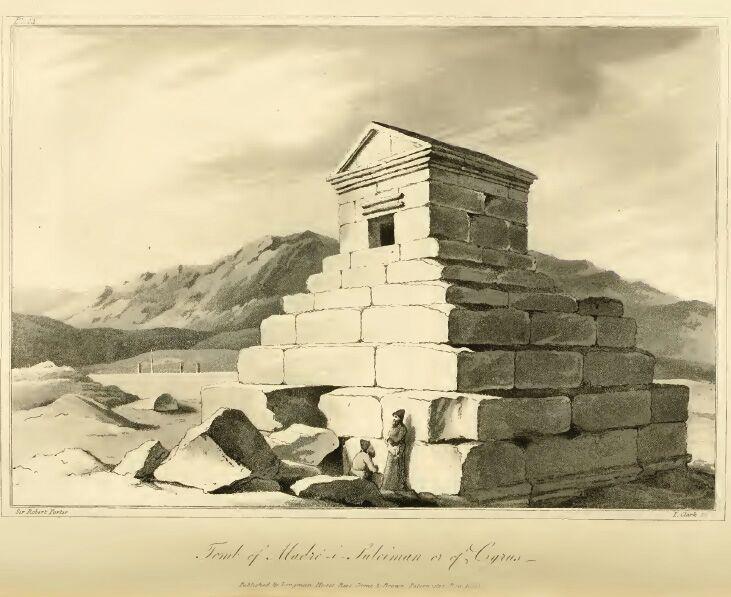
During the reign of the Atabakan of Fars over Shiraz, a mosque was built around the tomb under the misconception that it was the Tomb of Solomon’s Mother. The columns seen in the paintings by travelers might have been remnants of this mosque. In the Pahlavi era, these columns were removed from around Cyrus’s Tomb, making it the sole structure in the Murghab plain.
Restoration of the Tomb of Cyrus
The Tomb of Cyrus has undergone several restorations in contemporary times. The first notable restoration took place in 1971, during the reign of Mohammad Reza Pahlavi, under the supervision of Ali Sami, who was then the head of the Institute of Archaeology at Persepolis.
During this phase, architects used cement for the restoration, and the site, including the surrounding area of Cyrus’s Tomb, was utilized for the celebrations of the 2500th anniversary of the Persian Empire.
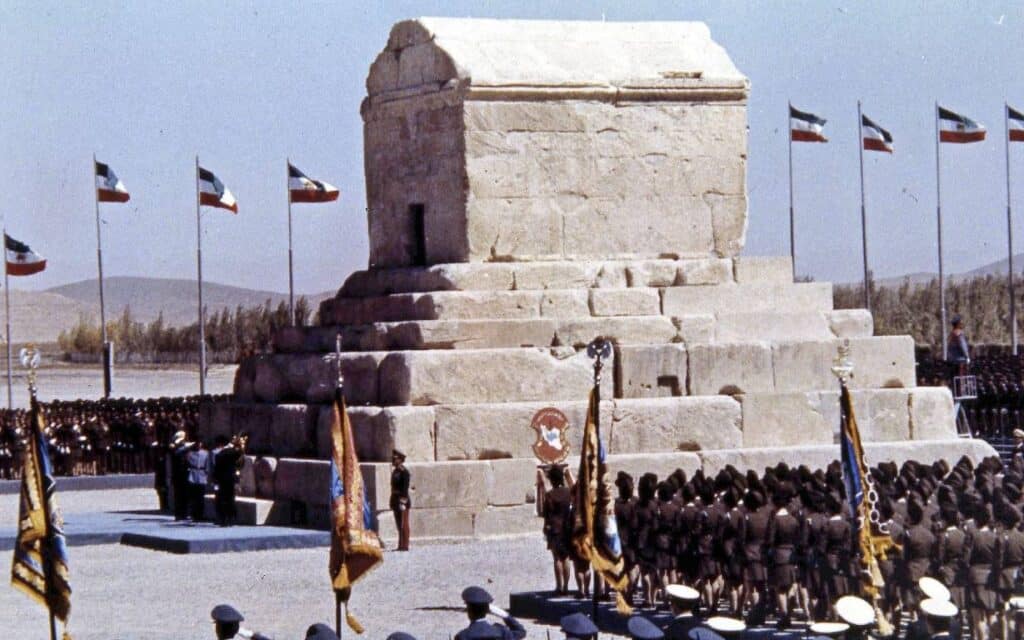
However, over time, the restoration suffered damage and deterioration. Between the years 2001 and 2008, the monument underwent another round of repairs, this time employing modern techniques and laser technology to enhance its resistance to rain and snow.
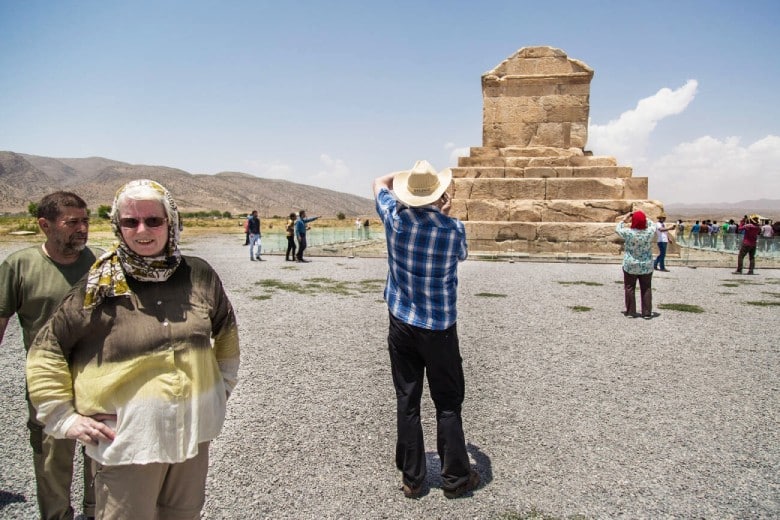
Documentary on the Tomb of Cyrus
Numerous documentary films have been made by tourists about the Tomb of Cyrus, but one film, in particular, remains that covers the restoration of the Tomb of Cyrus and its surrounding area.
This reconstruction was based on descriptions of the Pasargadae site found in historical sources. The film portrays the tomb during the Achaemenid period, showcasing the reconstructed palaces and gardens around the tomb, allowing viewers to witness these revitalized historical settings.
Attractions Around the Tomb of Cyrus
Historical sources and travelogues penned by explorers suggest that Cyrus’s Tomb was originally situated amidst the Pasargadae gardens, shaded from the sun and guarded round the clock to protect it from looters. Achaemenid kings would visit Cyrus’s Tomb for their coronation ceremonies, paying respects before donning their crowns.
Other significant structures in the Pasargadae site and around Cyrus’s Tomb included Tall-e Takht, the Throne of Solomon’s Mother, and the Fortress of Darius or Persepolis.
Darius the Great commenced the grand construction of Persepolis upon his accession to power, a project later completed by Xerxes and Artaxerxes I. The vast complex, spanning two hectares, featured columned halls, large platforms, numerous rooms, and storages, all unearthed by archaeologists.
Tang-e Bolaghi of Pasargadae
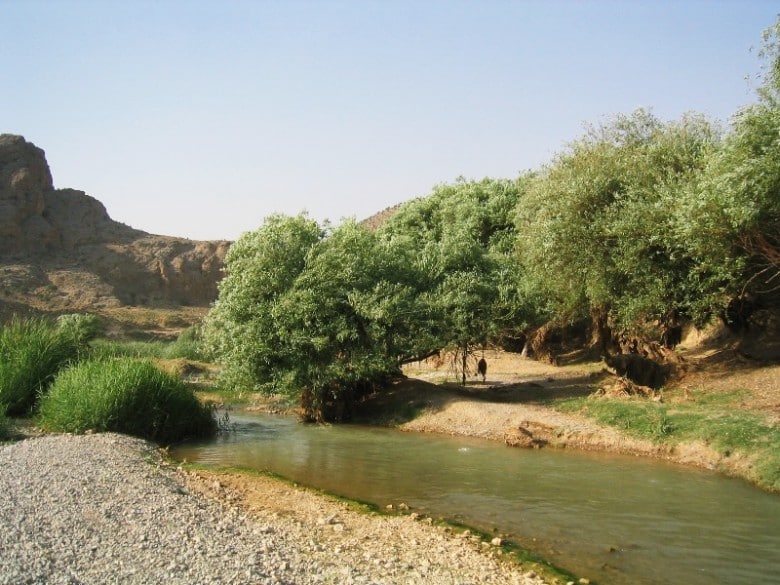
Tang-e Bolaghi is a renowned natural attraction near Cyrus’s Tomb in Fars province. Situated south of the Pasargadae ancient site, this gorge stretches over 18 kilometers. Its breathtaking nature appeals greatly to tourists. The Siwand river running through Tang-e Bolaghi creates a lush environment with a forested canopy of beautiful trees. Beyond its stunning natural beauty, Tang-e Bolaghi is also rich in archaeological sites, some predating the Achaemenid era, making it a prime natural and historical tourist attraction.
Pasargadae Garden
Pasargadae Garden is another attraction near Cyrus’s Tomb. Researchers consider this garden as part of the Persian gardens, known for their unique architecture. During the Achaemenid era, the garden housed palaces now lost to time. The garden’s architectural features have made it famous among researchers and archaeologists.
The Tomb of Cambyses

A structure in Pasargadae, believed to belong to the early Achaemenid period, is known as the Tomb of Cambyses and Solomon’s Prison. This tomb shares similarities with the Tomb of Cyrus the Great. Some archaeologists suggest it was initially a Zoroastrian fire temple. Known as Solomon’s Prison, this structure is made of stone blocks arranged to form a tower. Today, only one wall remains, visible en route to Pasargadae’s private palaces and the Audience Palace.
The Sacred Precinct of Pasargadae
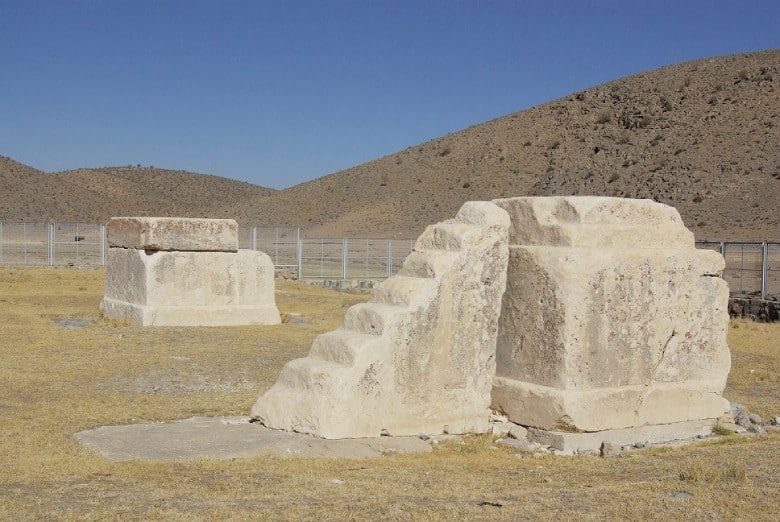
Another noteworthy structure near Cyrus’s Tomb is the Sacred Precinct of Pasargadae. Located northwest of Cyrus’s Tomb, behind a range of stone hillocks, the precinct features two white stone platforms and a rectangular stepped mound known as the “Sacred Precinct.” During the Achaemenid period, these platforms were used as altars and played a central role in ceremonial rituals.
BOOK ONLINE
Shiraz Hotels
Final Thoughts
The Tomb of Cyrus the Great is a significant tourist attraction in Marvdasht, Shiraz. Cyrus’s remarkable reputation resonates globally. The humanitarian persona of Cyrus, the Achaemenid king, holds profound significance for Iranians and history enthusiasts worldwide. As time progresses and the justice-based governance of Cyrus becomes more evident, the interest in visiting his tomb continues to grow.
Read More



